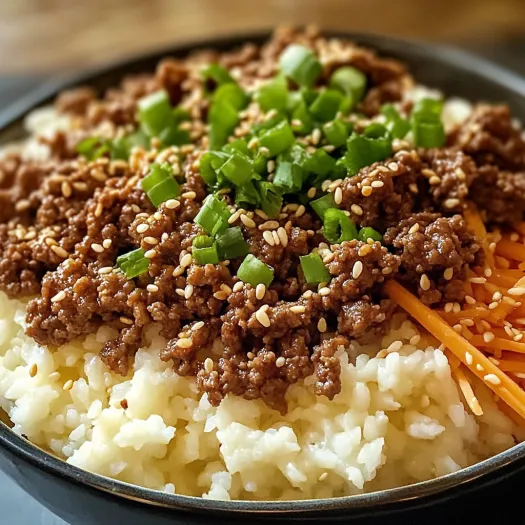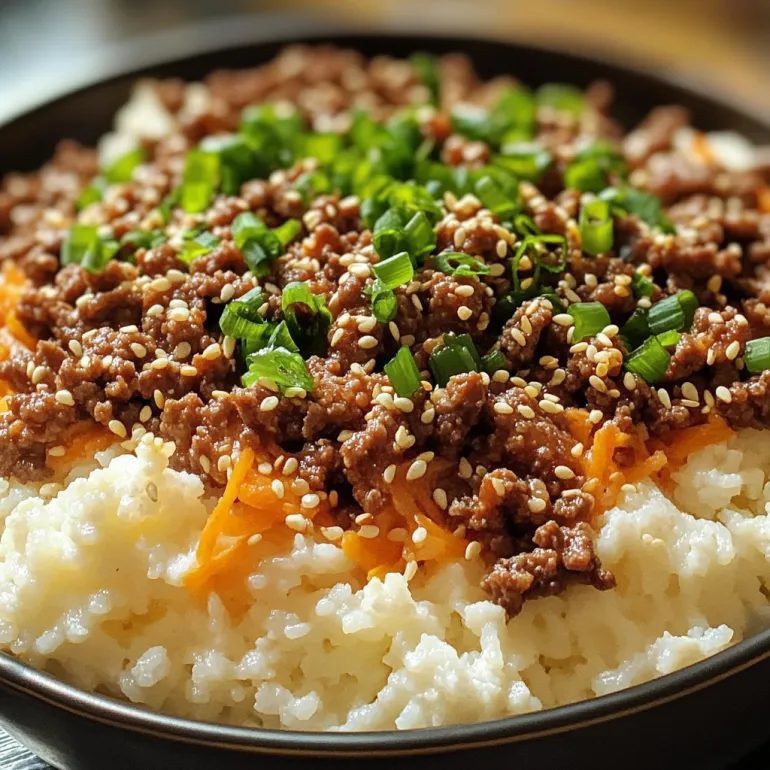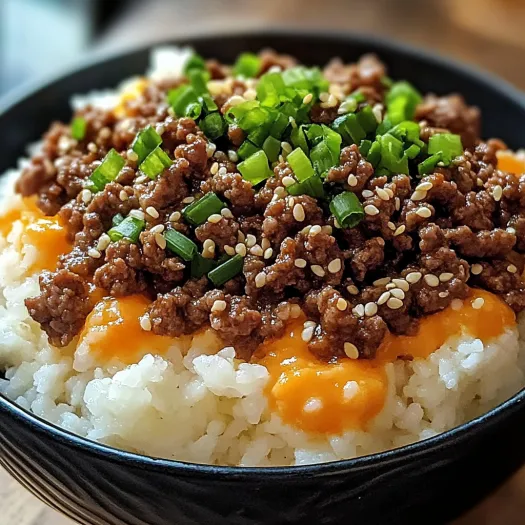 Pin
Pin
This quick Korean ground beef bowl has become my weeknight dinner hero when I need something delicious on the table in under 30 minutes. The combination of savory beef infused with garlic, ginger, and the perfect balance of soy sauce creates a meal that feels special despite minimal effort.
My family first discovered this recipe during a particularly hectic month when we needed fast dinners that still delivered on flavor. Now it appears on our meal plan almost weekly because everyone cleans their plates every single time.
Ingredients
- Ground beef: 80/20 lean to fat ratio ensures the perfect balance of flavor and juiciness without being greasy
- Soy sauce: Provides the essential umami foundation that makes this dish so satisfying
- Sesame oil: Adds that distinctive nutty flavor that makes Korean cuisine so distinctive
- Fresh garlic and ginger: Create an aromatic base that elevates the simple ingredients
- Green onions: Add brightness and color both cooked in the beef and as a fresh garnish
- Rice: Preferably jasmine for its fragrant quality that pairs perfectly with the savory beef
- Optional toppings: Like sesame seeds and kimchi take this simple bowl to the next level
Step-by-Step Instructions
- Prepare the Rice:
- Cook your rice according to your preferred method while you prepare the beef mixture. For jasmine rice, I rinse it thoroughly first to remove excess starch, then cook with a 1 to 2 ratio of rice to water. The rice forms the base of this dish, so taking the time to prepare it properly makes a significant difference in the final result.
- Brown the Beef:
- Start by heating your skillet over medium high heat until hot. Add the ground beef and break it into small pieces with a wooden spoon as it cooks. This step takes about 5 to 7 minutes, and you want to see a nice caramelization on some pieces for extra flavor. The beef should be completely browned with no pink remaining.
- Add the Aromatics:
- Once the beef is browned, add the minced garlic and ginger to the skillet. Stir constantly for about 60 to 90 seconds until you can smell their fragrance blooming in the pan. Be careful not to burn these aromatics as they can quickly go from perfectly fragrant to bitter if overcooked.
- Season and Finish:
- Pour in the soy sauce and sesame oil, then add the chopped green onions. This creates the signature Korean flavor profile that makes this dish so addictive. Let everything simmer together for about 2 minutes, allowing the beef to absorb all those wonderful flavors. Taste and adjust with salt and pepper if needed.
- Assemble Your Bowl:
- Start with a generous base of hot rice, then top with the seasoned beef mixture. Add any additional vegetables or toppings you desire. I like to arrange components in sections rather than mixing everything together, which creates a more visually appealing presentation and lets each element shine.
 Pin
Pin
This dish reminds me of my first attempt at Korean cooking after falling in love with the cuisine at a local restaurant. The ginger makes all the difference here. I remember my daughter declaring it even better than takeout, which might be the highest compliment a home cook can receive.
Make It Your Own
This Korean beef bowl welcomes adaptation based on what you have available. The core flavors of garlic, ginger, soy and sesame create the foundation, but beyond that, feel free to experiment. Try adding finely diced carrots, bell peppers, or zucchini to the beef mixture for extra nutrition. For heat lovers, stir in some gochujang paste or red pepper flakes.
Storage and Reheating
This dish makes excellent leftovers that actually improve overnight as the flavors meld together. Store the beef and rice separately in airtight containers in the refrigerator for up to 3 days. When reheating, add a small splash of water to the rice before microwaving to restore its moisture. The beef portion can be reheated in a microwave or quickly in a skillet with a tablespoon of water to prevent it from drying out.
Serving Suggestions
While delicious on its own, this Korean beef bowl pairs wonderfully with simple side dishes that complement rather than compete with the flavors. Try serving it with quick cucumber kimchi for a refreshing crunch, steamed broccoli drizzled with sesame oil, or a simple side salad dressed with rice vinegar and a touch of honey. For a more substantial meal, consider adding a fried egg with a runny yolk on top which creates a rich sauce when broken over the rice and beef.
 Pin
Pin
Frequently Asked Questions About the Recipe
- → What protein options work besides ground beef?
While traditional Korean beef bowls use ground beef, you can substitute ground turkey, chicken, or pork with excellent results. For vegetarian options, try crumbled tofu or tempeh seasoned with the same flavorful ingredients. Each protein absorbs the garlic, ginger, and soy flavors beautifully while offering different nutritional profiles.
- → How can I make this dish spicier?
To add heat, incorporate 1-2 tablespoons of gochujang (Korean chili paste) or 1-2 teaspoons of red pepper flakes into the beef mixture while cooking. Sriracha or your favorite hot sauce works well too. For a milder approach, drizzle chili oil over the finished bowl or add thinly sliced fresh jalapeños as a topping.
- → What side dishes pair well with Korean beef bowls?
Traditional Korean banchan (side dishes) complement this meal perfectly. Try kimchi, pickled daikon radish, cucumber salad, or sesame spinach. A simple side of steamed edamame or miso soup also works well. For a refreshing contrast, serve with a crisp green salad dressed with rice vinegar and sesame oil.
- → Can I prepare components ahead of time?
This dish is perfect for meal prep! The beef mixture can be cooked up to 3 days in advance and stored in the refrigerator. Rice can be prepared ahead and reheated or used cold. For freshness, store toppings separately and assemble just before eating. When reheating, add a splash of water or broth to the beef to prevent it from drying out.
- → What's the best rice to use for this bowl?
Medium-grain white rice offers the traditional Korean experience, but jasmine, basmati, or brown rice work excellently too. For a lower-carb option, try cauliflower rice sautéed with a bit of sesame oil. Short-grain rice provides a stickier texture that holds together well, while long-grain varieties give a fluffier result.
- → How can I make this dish gluten-free?
Simply substitute regular soy sauce with tamari or coconut aminos for a gluten-free version. Double-check that your sesame oil is processed in a gluten-free facility. All other ingredients in the basic recipe are naturally gluten-free, making this an easy dish to adapt for those with gluten sensitivities.
